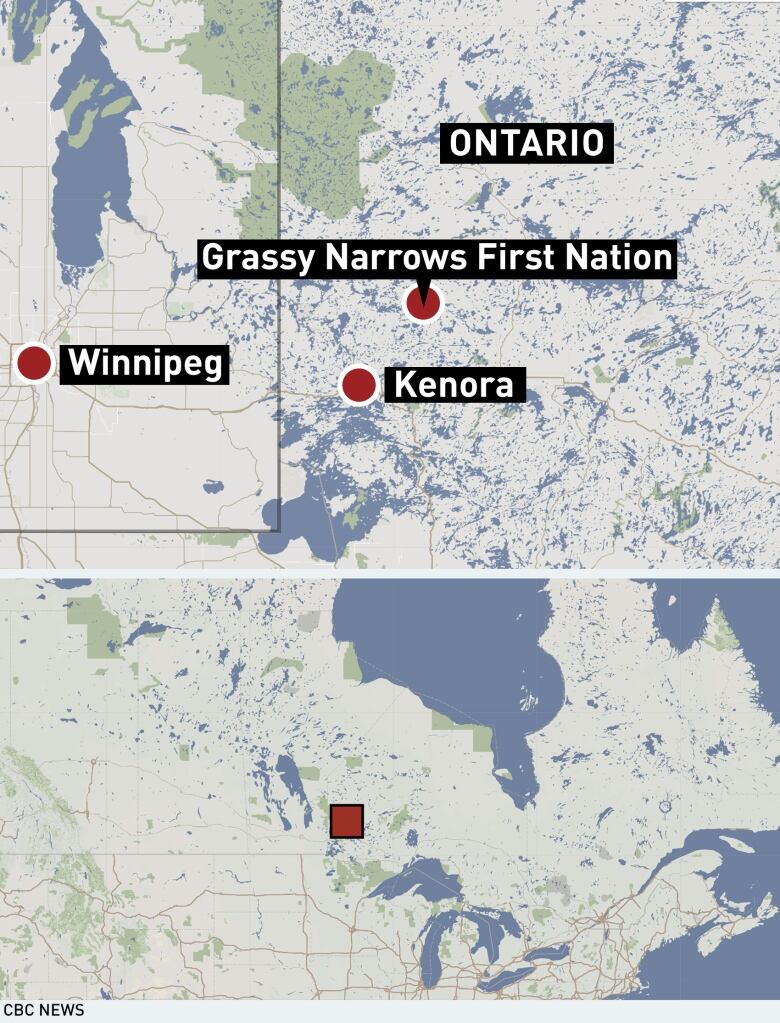Grassy Narrows First Nation looking at next options to protect land from mining activity in Ontario
Members of a First Nation in northwestern Ontario are back to the drawing board in their attempts to protect traditional lands from continued impacts of industrial activity.
Most recently, leadership from Asubpeeschoseewagong Anishinabek (Grassy Narrows) asked Ontario to inform companies and prospectors about the risks of staking a mineral claim in Grassy Narrows’s traditional territory.
Thanks to Ontario’s switch to a digital staking system in 2018, mining companies and prospectors can register a mineral claim in the territory from anywhere in the province without ever stepping foot in the area, and without knowing about the First Nation’s ongoing efforts to protect their lands.
The community sent a letter to the provincial mining recorder on Feb. 7, asking for a notice of caution to be placed on the online staking system to notify parties thinking of staking a mineral claim in the area.
“We believe that there is a considerable risk to companies that are staking, or that have staked claims in the subject area, because they are operating in a social conflict zone subject to ongoing litigation,” said the letter, which was obtained by CBC News.
In November 2021, Grassy Narrows took Ontario to court over nine mineral exploration permits they say the province granted in the First Nation’s traditional territory without consulting them.
LISTEN | Grassy Narrows member Joseph Fobister discusses court challenge
Up North6:08Grassy Narrows takes Ontario to court over mining permits
Grassy Narrows First Nation is taking Ontario to court. At issue are nine mining exploration permits granted to mining companies in the traditional lands of the First Nation. Grassy Narrows says those permits were granted without their consent or knowledge in spite of the First Nation’s declaration of a no-harvest zone. The notice of judicial review was filed to the Ontario Superior Court of Justice today. Joseph Fobister is the lead negotiator and an advisor to chief and council with Grassy Narrows First Nation. He spoke with the CBC’s Logan Turner. 6:08
Grassy Narrows has also been asking Ontario to withdraw the land from forest management planning and mineral staking since 2018, and they declared a moratorium on all industrial activity in the area since 2007.
“It appears that Ontario is not currently disclosing these risks to companies,” the letter said.
“It also fails to alert these companies that their claims are encumbered by Grassy Narrows’ rights and interests and that their ability to access and operate within their claims may be impeded by the social conflict arising from the Crown’s failure to respect our rights and interests.”

But Ontario’s provincial mining recorder disagreed with Grassy Narrows, responding in a Feb. 18 letter that denied the First Nation’s request to have a notice of caution issued.
“While there have been a few instances in which the Ministry has considered it appropriate to issue cautionary statements … regarding claims asserted by Indigenous communities, the underlying circumstances were materially different,” said mining recorder James Schweyer in the Feb. 18 letter.
The ministry did not provide additional details on why they refused the request in an emailed statement to CBC News. They also did not respond to questions asking how many notices of caution are currently approved in Ontario nor where they are located.
Growing legal uncertainty in northern Ontario
Dayna Scott said it was a missed opportunity to improve clarity and relationships between government, First Nations and industry in the mining sector, especially in the lands around Grassy Narrows. Scott is an associate professor at York University’s Osgoode Hall Law School and an expert in environmental law and justice.
Since Ontario Premier Doug Ford was elected in 2018 and vowed to “hop on a bulldozer” himself to build roads to the Ring of Fire and open northern Ontario to more resource development, there has been a growing number of legal challenges claiming the government has failed to adequately consult First Nations.
It’s led to more legal uncertainty in the mining industry in northern Ontario, Scott said, which is a concern given the Progressive Conservatives priority to expand mining in the north to boost the economy and facilitate a coming transition to electric vehicles and clean steel.

If the province placed more notices of caution on contested lands from the beginning, “companies would be warned of these risks in advance, and they would maybe think twice about staking claims within that territory,” Scott told CBC News.
“Or alternatively, the companies would be aware of those risks, they would stake there anyway, and then Ontario would have arguments in some future litigation that the company might bring, saying that the company should have been aware of those risks and the uncertainty related to the lands in question from the beginning.”
Land protection ‘for our children and grandchildren’
Joseph Fobister of Grassy Narrows has been involved in the work to protect the First Nation’s lands from industrial activity for more than two decades.
For him, it’s quite simple. He wants mining companies and prospectors to know about and respect the laws of Grassy Narrows, and he doesn’t want to see anymore logging or mining.
The people and the lands have already been through so much, he told CBC News, they need to heal from the decades of clear-cut logging, mining activity and mercury poisoning.
This fight is important not for myself, but for the community.– Joseph Fobister, Grassy Narrows First Nation resident
“We need to have something for our children and grandchildren, so this fight is important not for myself, but for the community.”
Since the government won’t apply a notice of caution, Grassy Narrows staff has taken it upon themselves to inform mining companies about their laws and the outstanding litigation.
Most of the companies have been “open to dialogue with Grassy,” said Fobister.
He added, “ultimately, they have to accept that we won’t accept any more resource extraction from our territory … and we’re not ready to make any deals until the community changes their mind.”

